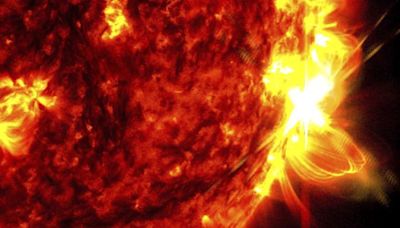搜尋結果
The earliest datable record of an aurora was recorded in the Bamboo Annals, a historical chronicle of the history of ancient China, in 977 or 957 BC. An aurora was described by the Greek explorer Pytheas in the 4th century BC. Seneca wrote about auroras in the first book of his Naturales Quaestiones, classifying them, for instance, as pithaei ('barrel-like'); chasmata ('chasm'); pogoniae ...
Airglow over Auvergne, France Yellow, green and red bands of airglow along Earth's limb as seen from space. Airglow (also called nightglow) is a faint emission of light by a planetary atmosphere.In the case of Earth's atmosphere, this optical phenomenon causes the night sky never to be completely dark, even after the effects of starlight and diffused sunlight from the far side are removed.
A substorm, sometimes referred to as a magnetospheric substorm or an auroral substorm, is a brief disturbance in the Earth's magnetosphere that causes energy to be released from the "tail" of the magnetosphere and injected into the high latitude ionosphere. Visually, a substorm is seen as a sudden brightening and increased movement of auroral arcs.
Aurora is an exascale supercomputer that was sponsored by the United States Department of Energy (DOE) and designed by Intel and Cray for the Argonne National Laboratory. [2] It has been the second fastest supercomputer in the world since 2023. It is expected that after optimizing its performance it will exceed 2 ExaFLOPS, making it the fastest ...
Aurora Aksnes ( Norwegian pronunciation: [æʉ̯ˈɾùːɾɑ ˈɑ̂ksˌneːs]) (born 15 June 1996), [2] [3] known mononymously as Aurora (stylised in all caps), [4] is a Norwegian singer, songwriter and record producer. Born in Stavanger and raised in the towns of Høle and Os, she began writing her first songs and learning dance at the age of six.
The High-frequency Active Auroral Research Program ( HAARP) is a University of Alaska Fairbanks program which researches the ionosphere – the highest, ionized part of Earth's atmosphere . The most prominent instrument at HAARP is the Ionospheric Research Instrument (IRI), a high-power radio frequency transmitter facility operating in the high ...
A subauroral ion drift ( SAID ), also known as a polarisation jet, is an atmospheric phenomenon driven by substorms in the Earth's magnetosphere. [1] First discovered in 1971, [2] a SAID is a latitudinally narrow (1-2° MLAT) layer of rapid, westward flowing ions in the Earth’s ionosphere. Though not traditionally associated with an optical ...






